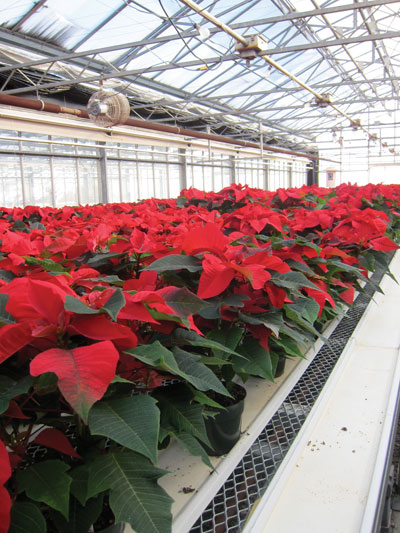
Use a combination of good cultural practices, regular monitoring and early intervention with biologicals
Use a combination of good cultural practices, regular monitoring and early intervention with biologicals
 |
|
| This year has been a challenging one for poinsettia production. Advertisement
|
With thoughts of the summer heat fresh in our minds, the last thing many people are concerned with is Christmas. Poinsettia growers, on the other hand, are a little different as they head into a critical production time for this December favourite.
Although many insects and mites can infest poinsettias – periodically fungus, gnats, mites and mealy bugs – the most common pest is the whitefly. There have been several evolutions in the whitefly story. Until the 1980s, the greenhouse whitefly was prevalent but it was displaced by the sweet potato or silverleaf whitefly. This whitefly, also known as Bemisia (‘B’ biotype), is the major insect pest of concern.
The story has become even more complex, with the emergence of another Bemisia biotype in 2004 and 2005, known as the ‘Q’ biotype. Biotype Q can be difficult to control because it is resistant to even more pesticides than the ‘B’ biotype. That said, every year is different in terms of the extent of whitefly problems and the level of infestation in different poinsettia varieties.
The emergence of resistant biotypes and inconsistent control provided by pesticides has prompted growers to shift to preventive pest management from reactive pest management. Many growers now effectively use biological control techniques to provide season-long control with minimal to no pesticide inputs. This is currently the most reliable strategy.
The foundation of most biological control strategies is provided by parasitic wasps such as Encarsia formosa, Eretmocerus eremicus and Eretmocerus mundus. Cards carrying the parasitized scales should be placed throughout the crop from day one, with repeat introductions every week.
Some growers also use the predatory mite Amblyseius swirskii or tiny black ladybeetles, Delphastus catalinae, to treat hot spots. If initial infestations are heavy, biopesticides such as BotaniGard (Beauveria bassiana) or NoFly (Isaria fumosorosea – formerly Paecilomyces fumosoroseus) can be used to supplement a biocontrol program, particularly when plants are small and thorough under-leaf spray coverage can be done.
Research at the University of Guelph into immersion treatments for whitefly-infested cuttings has shown that this preventive technique may also be useful for a range of different biopesticides. This strategy is being pursued with registrants to add these uses to labels.
This year has been a challenging one for poinsettia production. Cuttings arrived in July infested, and some heavily, with mixed populations of B and Q biotypes. Pesticides that had been applied to stock plants were not effective and pesticide residues on the cuttings made it difficult to establish biocontrol programs.
This issue shows why it is important to monitor new cuttings to implement chemical or biologicial control measures in a timely way, throughout the crop cycle
Applications of a pesticide such as Forbid were recommended in Ontario, as the pesticide is reasonably compatible with the parasitic wasps used for whitefly control.
By using a combination of good cultural practices, regular monitoring and early intervention with biologicals, growers should produce a great Christmas crop.
For more information on this article, contact Michael Brownbridge (michael.brownbridge@vinelandresearch.com) or Rose Buitenhuis (rose.buitenhuis@vinelandresearch.com) at Vineland Research and Innovation Centre, or Graeme Murphy (graeme.murphy@ontario.ca) at Ontario Ministry of Agriculture, Food and Rural Affairs.
Vineland Research and Innovation Centre is funded in part by Growing Forward, a federal-provincial-territorial initiative. • www.vinelandresearch.com
Print this page